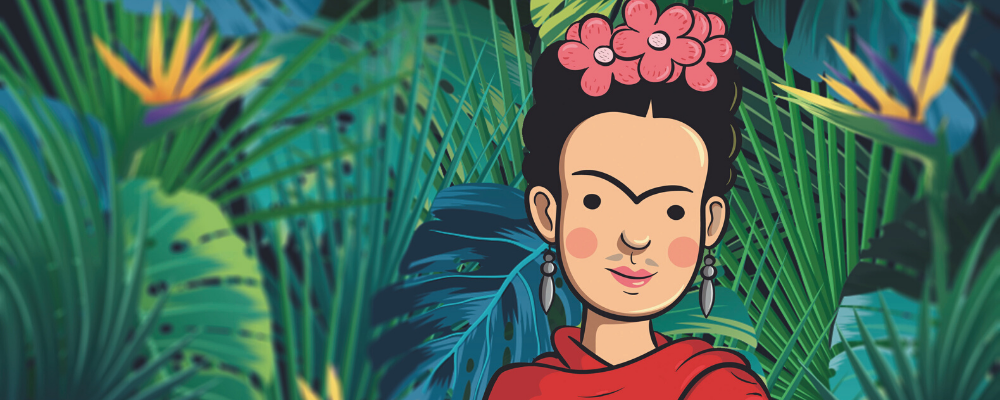The Anti-princess Series is a series of biographies written by the authors Nadia Fink and Pitu Saa, with the intention of bringing children to a counter-stance against which the gender roles are reinforced and the borders are repeatedly drawn.
The Anti-princess Series is a series of biographies written by the authors Nadia Fink and Pitu Saa, with the intention of bringing children to a counter-stance against which the gender roles are reinforced and the borders are repeatedly drawn. Nota Bene Publications translated the series into Turkish. The first focus of the series is the unusual appearance and attractiveness that pushes the boundaries of gender roles, strength, and resistance; in short, Frida Kahlo, who has recently been a popular image, truly came out as anti-princess with her life and art.
The book has a feature that breaks the sexist codes created in children’s minds; compares women's and men's lives with different life stories; allows children to look outside of the world which keeps the lives of designated roles, and which permits men to dominate the movement areas, thus saves the women. Frida Kahlo, in this sense, is a good choice as a starting point for the series because of her strong stance despite the difficult conditions of both her own times and personal adventure. Frida Kahlo, whose one leg is shorter than the other because of her illness she got when she was six, gets education in a place where girls are the minority, and is known as a “funny, talented, smart and rebellious” but no longer as a crippled girl. She had a bus accident that would push her to bed, has been suffering of pain for a very long time. She took her first steps to painting when she had to spend all her time in bed afterwards. Her mustaches and eyebrows that she emphasizes in her self-portraits, her relationship with her husband Diego Rivera, and her communist character; all these are given place with the questions of a curious dog who leads the story. The life story that is formed by the combination of all these anti-princess properties has thus brought the adventure of a different character to children.
However, the direction in the text is not only based on questions of the curious dogs, but also in defining some concepts in the narrative by including them in the tutorial boxes. One of these concepts is revolution. With the definition of the concept in the book, it is possible to say that the text makes a great effort to place Frida's life on a totally ideological level with her communist identity. At this point, the other side of Frida, which transcends this limitation and makes her a powerful individual, remains in the shade, and even so, her painful relationship with Diego Rivera is read completely in the context of the revolution.
When Frida is on the one side of a love story, one of the most obvious distribution areas of gender roles in the text, Diego is placed as an anti-prince on the other side of this love. For this reason, Frida's approach to painter Diego also differs in this sense. Both Frida's and Diego's relationships with other people during their marriage and their love stories are told not as an innocent and immortal love that we are familiar with. Ultimately, the divorce due to infidelity and subsequent re-marriages of Frida and Diego are interpreted as "a sharing beyond a habit of that time." Since they are two individuals who have experience of the revolution and have lived in a country where everything is changed to a completely different one. In the book, the revolution written in bold letters is taken into the box and a very didactic definition about it is made. According to this, the revolution is "changing bad things in a good way" (Fink 12).
At this point, however, the ideology that began to dominate the story comes to the fore, leaving behind a biography of a powerful woman. It is also overlooked that there may be alternative definitions and readings of this notion while attempting to fit Frida's life and love into a revolutionary context. At this point, I think, it is worth remembering Fuentes' description of the "unfortunate country" that he made for Mexico in his novel about the twentieth-century Mexico. Accordingly, Mexico is an unfortunate country where "every descendant destroys the previous masters, and bring new masters who are as greedy as the previous ones" (Fuentes 55). Perhaps it is not a life that is lived in the arms of the "good" versions of revolutions which makes Frida special. Kahlo was able to demonstrate her existence with a determination and resistance which clears the sex codes in a gray, complex, and slippery time zone without a need to hide her disadvantaged body. Just as the "misfortunes" of Latin America make it different, it must be the most prominent point that Frida could have shown with her misfortunes and sorrows that made her totally different, and with her love that is not exempt from all these anguish, her political stance, and her art, of course. Although Frida's strong stance is underlined in the book, which is contrary to the gender roles, reading the parts about her life between the boundaries of the good and the evil, trying to place it on an ideological basis, imposing another “good” while objecting the “good” which is enforced by the world of princes and princesses, it seems to be the weakest part of the text.
Considering its aims, the Anti-Princess Series has emerged as a very exciting idea for both us and the age group that it addresses. As the first focus of the series, Frida Kahlo emerges as a real anti-princess and opens the horizons because of its form of existence in the fields where the traces of women are removed. However, the didactic elements in the text almost frames Frida's position as a strong woman with ideological boundaries, and darken reading her life beyond this ideological level. However, it is easy to say that we have met with a considerable series that encourages to think, produce and exceed certain codes, just as it is in the activities recommended to children at the end of the book.
Bibliography
Fink, Nadia. Antiprenses Serisi: Frida Kahlo. Res. Pitu Saa. Çev. Nergis Turan. İstanbul: Nota Bene Yayınları,
2017.
Fuentes, Carlos. Artemio Cruz’un Ölümü. Ankara: Can Yayınları, 1983.

